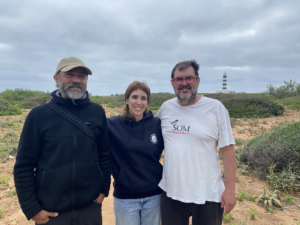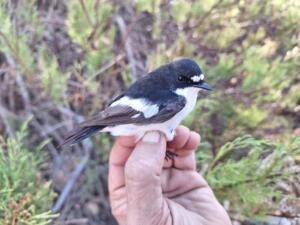Preliminary data from the SOM’s bird ringing campaign
“Experts warn that it is essential to continue funding migration study campaigns on the Isla del Aire to identify the possible effects of climate change on the populations of these migratory birds”

The bird ringing campaign for the study of prenuptial migration on the Isla del Aire carried out by the Societat Ornitològica de Menorca (SOM), with the support of Menorca Preservation, has witnessed a general decline in the number of birds ringed, as well as the number of species recorded, during this migration. Thus, the overall results of ringing indicate a decrease of more than 44% of the historical average number of captures of the study, three days after concluding the fieldwork, which has been carried out under the same conditions and methodology since 1995.
The experts warn that they cannot draw global conclusions based solely on the data from this campaign and without taking into account other study stations located at the different key points of the migratory journey of these birds. Even so, they suspect that the effects of climate change could be the cause of this decline in catches. The lack of rainfall in autumn in the Sahel area (hibernation area of most passerine nesting birds in Europe) and the heat wave at the end of winter in the same area, with very significant temperature records, seem to be some of the main causes of this significant drop in captures.
For this reason, the experts consider it essential to protect and preserve the small islands of the Mediterranean, such as the Isla del Aire, as “places of great interest” for the conservation of small migratory birds, as well as to continue funding this type of studies, in order to have their own rigorous data and to be able to monitor the possible effects of climate change on this natural environment, which is so important for the survival of many of these species.
Pre-Saharan migrant bird bandings have declined the most
The robin (Erithacus rubecula) -94.9%, the common chiffchaff (Phylloscopus collybita) -50.9% or the blackcap (Sylvia atricapilla) -70.9%, are the three most abundant and representative species of this group of migrants. However, this year they have been ringed well below historical numbers (1995-2024). These birds migrate from northern to central Europe to the Mediterranean area and North Africa (without crossing the Sahara desert) and, although the migration of this group of birds, which basically takes place during March, could involve some variations due to the starting date of our campaign, experts have never recorded such low results.

Trans-Saharan species have also shown a decline
These birds migrate from the European continent to beyond the Sahara desert, in some cases as far as South Africa, and are the group of birds that the experts are seeking to study through this study. The musical warbler (Phylloscopus trochilus) – 43.5%, the redstart (Phoenicurus phoenicurus) – 30, 7%, Nightingale (Luscinia megarhynchos) -37.3%, Subalpine Warbler* (Warbler cantillans, Subalpine Warbler and Iberian Warbler)-43.9% and Willow Warbler (Warbler communis) -48.7%.
The Pied Flycatcher (Ficedula hypoleuca) +24.3% and the Grey Flycatcher** (Muscicapa striata/tyrrhenica) +37%, are the only two species considered abundant within the study that have been slightly above the historical average, always with data from 12 May, three days before the end of the campaign.
One new species recorded and two rare species ringed
The blue tit (Cyanistes caeruleus), a very common species on the peninsula that even breeds in Mallorca, has been identified and ringed for the first time in Menorca thanks to this year’s campaign. On the other hand, two species considered rare in Spain have also been ringed: the warbler (Warbler) and the collared flycatcher (Ficedula albicollis), of which 13 specimens have been ringed, 11 of them on the same day. The study had only 13 birds ringed to date, since 1995, and this is one of the most remarkable milestones of the 2024 campaign.
*Note: The Subalpine Warbler is a species that has recently been separated into three different species. In order to be able to compare the catches of the last years with the first ones, we have counted the catches of the three different species as if they were one sole.
*Note: As in the case of the Garden Warbler, the Grey Flycatcher has also been separated into two different species. In order to be able to compare the catches of recent years with those of earlier years, we have counted the catches of the two species as if they were one sole.